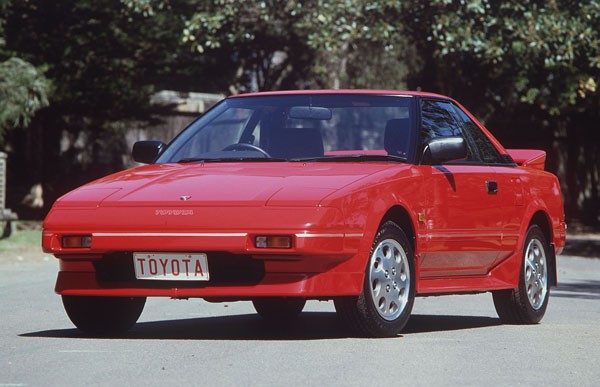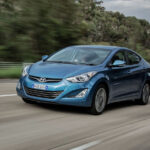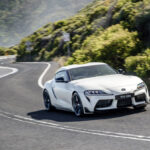The huge success of the Toyota 86 in Australia, indeed globally, has reminded people that Toyota doesn’t only make sensible but boring cars, it also builds excellent sports machines. These have been somewhat short on the ground over the last decade or so, but quite a few Toyota Celicas and MR2s are still on Australia roads.
Let’s look at the MR2 in detail: the name stands for Mid-engined Roadster 2-seats and MR2s are often bought by those who would dearly love a Ferrari but are a few hundred thousand dollars short of the necessary folding stuff.
All real sports cars and racing cars have a mid-engine layout as it gives the best possible balance and traction. However there are some drawbacks in the handling department. Like many other mid-engined cars the Toyota MR2 can be tricky when it approaches its limit of adhesion. The difference between being in control and out of control is relatively narrow.
At-the-limit handling improved with the second-generation Toyota MR2 of March 1990 and again with a revamp of the suspension in February 1992.
Drivers without proper training and/or who drive in a sloppy manner should perhaps go for a less pure car than the MR2, though if you only want a cruiser and have no intention of driving it hard it may work fine for you.
Then again, do you really want a pure sports car that won’t extend you when you’re behind the wheel, particularly on track days?
The MR2 is typically Toyota in the reliability stakes in that it can run for years on end without problems if driven maintained correctly.
Obviously, this is after all a sports model and some have been thrashed on the road or even pushed to the limit at racetracks.
As it is strictly a two-seater, the Toyota MR2 is relatively spacious in its cabin because there’s no need to compromise on squeezing in another pair of seats. Try before you buy, though, if your previous driving has only been done in hatches or non-sporty coupes.
Boot space is better than average for a car of this type. Mid-engined machines are notoriously bad in this aspect, but the Toyota is capable of holding a week’s shopping, or even holiday luggage if you are careful with your packing.
Until the third-generation model of 2000 the Toyota MR2 was a closed coupe with a targa top, from then on it was a full convertible.
From October 1987 until March 1990 the sporty little MR2 was powered by a four-cylinder engine of just 1.6 litres. Later models had a 2.0-litre unit which significantly improved performance, though these cars are still far from being the powerhouses you would expect from their styling.
The MR2 convertible has a high-tech 1.8-litre four-cylinder engine and is by far the best in the performance stakes. It has to be revved hard to get the best from it, but that’s part of the joy of driving a true sports machine.
A conventional five-speed manual gearbox is fitted in all versions of the coupe.
However, the convertible has a sequential manual setup in which the driver doesn’t have to use a clutch pedal but still has to make your their own gearchanges. Like all of its type this gearbox is an acquired taste, but not too bad once you get the hang of it. The sequential manual gearbox has five forward ratios until late 2002 when a six-speed unit was installed,
This Toyota sports is not an easy car to work on as the mid-mounted engine/transmission assembly is hard to reach. Professional mechanics generally remove the complete transaxle and work on it on a bench. If you don’t have the equipment to do this yourself the MR2 may prove a very expensive car to repair.
Spare parts are reasonably priced, but bits of the first generation MR2s are now becoming rare. The Toyota dealer network is huge but the remote agents probably won’t have parts in stock. Naturally, these people can order parts in should you find yourself stranded in the bush.
Insurance companies tend to be wary of sports cars, and this Toyota is certainly a full-on sports machine of the type that makes insurers nervous. Shop around for the best deal but make sure you are comparing apples with apples, and ask questions if one company seems to be a lot cheaper than the others.
Toyota MR2 quietly disappeared from the Australia market in March 2006, though some may not have been sold and registered until quite late in the year.
Although the Toyota MR2 was a victim partly of its quirky gearbox, it died chiefly because of the swing away from sporty models amongst trendy buyers.
WHAT TO LOOK FOR
Look for heavy brake-dust buildup on the insides of the wheels and on the front suspension components. Uneven tyre wear caused by hard cornering is easy to spot – be suspicious of tyres that have recently been renewed.
Look for previously repaired crash damage: sight along the length of the panels for a ripply finish indicating they have been panel beaten; look for a mismatch in paint colours between panels; see if there are any small paint spots on unpainted areas such as glass and plastic parts.
Check for poorly repaired areas of body in out of sight areas such as in the front ‘bonnet’, the rear boot and the engine compartment.
Severe engine wear may make an MR2 reluctant to start. It’s usually worst when stone cold so try to arrange to get to the engine first thing in the morning.
If the engine smokes from the exhaust and/or the oil filler plug it’s probably due for a major overhaul. Smoking is at its worst when the engine is left to idle for a minute or so, then accelerated hard.
Gearchanges should be smooth and easy, with light clutch movement.
Crunching gearchanges from a manual box is a sign of wear, the three-two downshift is usually the first to suffer.
Have a good look at the interior, including under the carpets, in case an MR2 convertible has been caught out in the rain with its top down.
Look for a roll-cage or signs that one has been removed, an indication the car has had serious racetrack use.
Extra instruments, bigger wheels and tyres, a body kit, sports seats and the like may also mean an MR2 has been fanged, though it’s more likely they are just there to improve the looks.
HOW MUCH?
Expect to pay from $1000 to $2000 for a 1987 MR2 coupe; $2000 to $4000 for a 1995 GT; $4000 to $6000 for a 1994 Bathurst; $11,000 to $17,000 for a 2004 TTR LE; and $14,000 to $20,000 for a 2006 Spyder.
CAR BUYING TIP
If looking to buy a car that’s loved by enthusiasts it’s always a good idea to contact a car club for the marque. The guys and gals there may even know details of the specific car you have in mind.














